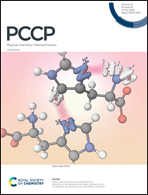A critical evaluation of the catalytic role of CO2 in propane dehydrogenation catalyzed by chromium oxide from a DFT-based microkinetic simulation†
Abstract
Propane dehydrogenation under CO2 is an important catalytic route to obtain propene with a good balance between selectivity and stability. However, a precise description of the catalytic role of CO2 in propane dehydrogenation is still absent. In this work, we focus on the elucidation of the role of CO2 by using DFT-based microkinetic simulation. The influence of CO2 is categorized as direct and indirect effects. It was found that the chemisorbed CO2 can directly abstract hydrogen from propane and propyl with a comparable barrier to the counterpart at the surface oxygen site. On the other hand, the dissociation of CO2 yields active surface species of CO* and O* which are actively involved in the removal of surface hydroxyls. It is found that the TOFs of both propane conversion and propene formation are significantly increased with the presence of CO2, which is explained by the reduced apparent activation energy. The primary hydrogen abstraction is identified to be the most influential step from the DRC analysis. The main effects of CO2 are concluded to be removing hydrogen and restoring oxygen vacancies from reaction pathway analysis.



 Please wait while we load your content...
Please wait while we load your content...